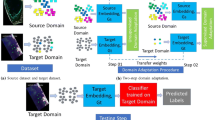Abstract
In a zinc flotation process, the concentrate grade is an important indicator which cannot be measured online. To ensure the stability of the process, deep learning has been widely used for the prediction of concentrate grade. However, grade prediction based on deep learning leads to the dataset bias problem, which caused by illumination change, environment noise, etc. A popular network for addressing this problem is the domain adversarial neural network (DANN), which cannot predict the domain label according to data distribution and extract global information. To overcome these limitations, we propose a new method, the wasserstein-transformer domain adversarial neural network (WT-DANN), which uses transformer to extract global features and calculates domain loss with wasserstein distance. We evaluated our approach on public dataset (Office31) and flotation dataset. On the Office31 dataset, WT-DANN achieved a better cross-domain accuracy than that of DANN. For the flotation dataset, WT-DANN's cross-domain prediction accuracy was 60.7%, compared to DANN's accuracy of 51.2%.







Similar content being viewed by others
References
I. Jovanović, and I. Miljanović, Miner. Eng. 70, 228 (2015).
I. Jovanović, I. Miljanović, and T. Jovanović, Miner. Eng. 84, 34 (2015).
J. Luo, Z. Tang, H. Zhang, and Y. Xie, IEEE Trans. Instrum. Meas. 70, 1 (2021).
Y. Xie, J. Wu, D. Xu, C. Yang, and W. Gui, IEEE Trans. Ind. Electron. 64(5), 4199 (2016).
B.J. Shean, and J.J. Cilliers, Int. J. Miner. Process. 100(3–4), 57 (2011).
Z. Tang, C. Zhu, and J. Liu, Appl. Res. Comput. 28(10), 3934 (2011).
T.G. Dietterich, Neural Comput. 10(7), 1895 (1998).
Y. Jiang, J. Fan, T. Chai, J. Li, and F.L. Lewis, IEEE Trans. Ind. Inform. 14(5), 1974 (2017).
S.H. Morar, M.C. Harris, and D.J. Bradshaw, Miner. Eng. 36, 31 (2012).
C. Marais, and C. Aldrich, IFAC Proc. Vol. 43(9), 104 (2010).
J. Li, T. Chai, F.L. Lewis, J. Fan, Z. Ding, and J. Ding, IEEE Trans. Ind. Electron. 65(5), 4092 (2017).
J.T. McCoy, and L. Auret, Miner. Eng. 132, 95 (2019).
A. Jahedsaravani, M.H. Marhaban, and M. Massinaei, Miner. Eng. 69, 137 (2014).
Z. Li, and W. Gui, Asian J. Control 20(6), 2223 (2018).
O. Russakovsky, J. Deng, H. Su, J. Krause, S. Satheesh, S. Ma, Z. Huang, A. Karpathy, A. Khosla, M. Bernstein, A.C. Berg, and F. Li, Int. J. Comput. Vis. 115(3), 211 (2015).
A. Torralba and A.A. Efros, Unbiased look at dataset bias, in Proceedings of the IEEE Conference on Computer Vision and Pattern Recognition (2011), pp. 1521–1528
M. Ghifary, W.B. Kleijn, M. Zhang, D. Balduzzi, and W. Li, Deep reconstruction-classification networks for unsupervised domain adaptation, in European Conference on Computer Vision (2016), pp. 597–613
E. Tzeng, J. Hoffman, T. Darrell, and K. Saenko, Simultaneous deep transfer across domains and tasks, in Proceedings of the IEEE International Conference on Computer Vision (2015), pp. 4068–4076
X. Wang, L. Li, W. Ye, M. Long, and J. Wang, Transferable attention for domain adaptation, in Proceedings of the AAAI Conference on Artificial Intelligence, vol. 31, no. 1 (2019), p. 5345
Y. Ganin, E. Ustinova, H. Ajakan, P. Germain, H. Larochelle, F. Laviollete, M. Marchand, and V. Lempitsky, J. Mach. Learn. Res. 17(1), 2096 (2016).
M. Long, Y. Cao, Z. Cao, and M.I. Jordan, IEEE Trans. Pattern. Anal. 41(12), 3071 (2018).
H. Yan, Y. Ding, P. Li, Q. Wang, and W. Zuo, Mind the class weight bias: weighted maximum mean discrepancy for unsupervised domain adaptation, in Proceedings of the IEEE Conference on Computer Vision and Pattern Recognition (2017), pp. 2272–2281
M. Long, H. Zhu, J. Wang, and M.I. Jordan, Deep transfer learning with joint adaptation networks, in International Conference on Machine Learning (2017), pp. 2208–2217
J. Shen, Y. Qu, W. Zhang, and Y. Yu, Wasserstein distance guided representation learning for domain adaptation, in Proceedings of the AAAI Conference on Artificial Intelligence, vol. 32, no. 1 (2018)
N. Courty, R. Flamary, A. Habrard, and A. Rakotomamonjy, in Advances in Neural Information Processing Systems (2017), pp. 3733–3742
B.B. Damodaran, B. Kellenberger, R. Flamary, D. Tuia, and N. Courty. Deepjdot: deep joint distribution optimal transport for unsupervised domain adaptation, in Proceedings of the European Conference on Computer Vision (2018), pp. 447–463
C.Y. Lee, T. Batra, M.H. Baig, and D. Ulbricht, Sliced Wasserstein discrepancy for unsupervised domain adaptation, in Proceedings of the IEEE Conference on Computer Vision and Pattern Recognition (2019), pp. 10285–10295
E. Tzeng, J. Hoffman, K. Saenko, and T. Darrell, Adversarial discriminative domain adaptation, in Proceedings of the IEEE Conference on Computer Vision and Pattern Recognition (2017), pp 7167–7176
Z. Pei, Z. Cao, M. Long, and J. Wang, Multi-adversarial domain adaptation, in Proceedings of the AAAI Conference on Artificial Intelligence, vol. 32, no. 1 (2018), pp. 3934–3941
C. Villani, Optimal Transport: Old and New (Springer, Berlin, 2009).
K. Saenko, B. Kulis, M. Fritz, and T. Darrell, Adapting visual category models to new domains, in Proceeding of the 11th European Conference on Computer Vision (2010), pp. 213–226
Acknowledgements
This work was supported by the State Key Program of National Natural Science Foundation of China (Grant No. 62233018) and the Natural Science Foundation of Hunan Province, China (Grant No. 2021JJ30862).
Author information
Authors and Affiliations
Corresponding author
Ethics declarations
Conflict of interest
The authors declare that they have no conflict of interest.
Additional information
Publisher's Note
Springer Nature remains neutral with regard to jurisdictional claims in published maps and institutional affiliations.
Rights and permissions
Springer Nature or its licensor (e.g. a society or other partner) holds exclusive rights to this article under a publishing agreement with the author(s) or other rightsholder(s); author self-archiving of the accepted manuscript version of this article is solely governed by the terms of such publishing agreement and applicable law.
About this article
Cite this article
Cen, L., Li, X., Chen, X. et al. Unsupervised Domain Adaptation for Grade Prediction of Froth Flotation Based on Wasserstein Distance and Transformer. JOM 76, 2362–2371 (2024). https://doi.org/10.1007/s11837-024-06446-0
Received:
Accepted:
Published:
Issue Date:
DOI: https://doi.org/10.1007/s11837-024-06446-0




